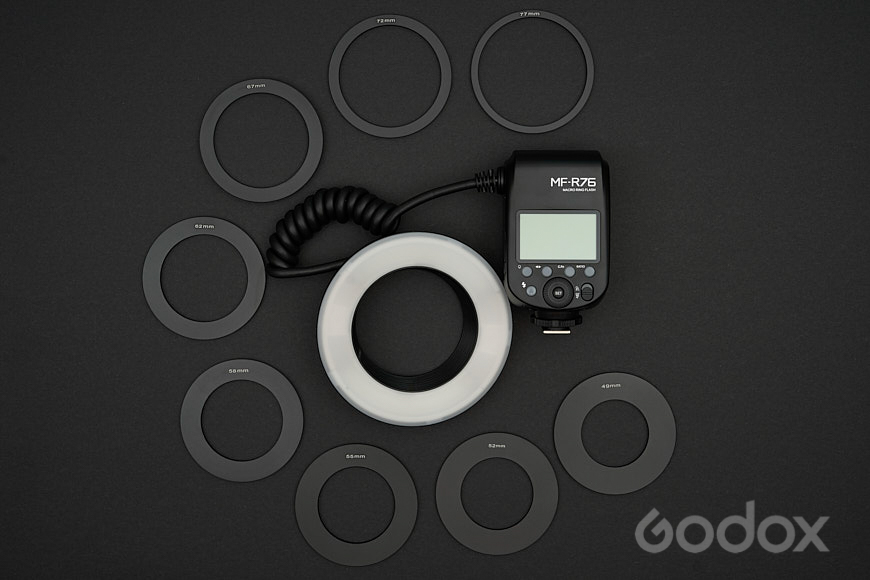
When Godox entered the flash market, it was a game-changer for the industry. Their AD200 range opened the door to photographers without gold plated budgets: not only was Godox cheap, but the light quality was also on a par with professional lighting.
Since then, Godox has progressively expanded its range of speedlights and TTL strobes to include new offerings like LED studio lighting, light wands and macro flashes.
One of their latest offerings is the Godox Macro Ring Flash MF-R76. The 76 in the name indicates the power output of 76w, and the Ring indicates that this is a ring-style flash.
Unlike many other models in Godox’s lineup, this is a manual flash. It’s a move to keep the pricing low as they offer TTL alternatives.
Whilst macro photography can be fun, it’s not always as simple as buying a macro lens. It introduces two problems for photographers, both of which relate to light.
The first of these relates to the availability of light. Macro requires shooting at f/8 or smaller apertures due to depth of field implications. This limits the available light. Longer exposures and tripods solve the problem for static objects, but shooting a bee with long exposure would pose problems.
The second relates to the flash itself. Using a conventional speedlight causes shadows from the lens on the subject due to the lens’s proximity to the subject. Even bouncing a flash off the ceiling can cause shadow issues.
In the past, I’ve gotten away with this on my camera product shots by shooting a little further back from the subject and cropping, but it isn’t ideal. You lose a fair amount of resolution with this approach.
This is where specialised macro flashes come into play. They attach to the front of the lens, ensuring the subject is well lit whilst minimising the shadows you would get from conventional speedlights.
Compatible cameras: Canon, Nikon, Sony, Fuji, Olympus, Panasonic, Pentax
Flash Power: 76Ws
Guide Number: 14m
Flash Duration: 1/300 to 1/20000 Second
Recycle Time: Approx. 0.1 to 1.5 Seconds
Power Range: 1/1 to 1/128
Built-in battery: Lithium battery 7.2V 2600mAh
Full power flashes: Up to 660
Lens Compatibility: 49mm/52mm/55mm/58mm/62mm/67mm/72mm/77mm Filter Threads (via Included Adapter Ring)
Net weight: 458g
Dimensions (W x H x D): a2.8 x 4.7 x 2.0″ / 70.0 x 120.0 x 50.0 mm (Controller) 5.1 x 5.1 x 1.1″ / 130.0 x 130.0 x 27.0 mm (Ring)
Build Quality
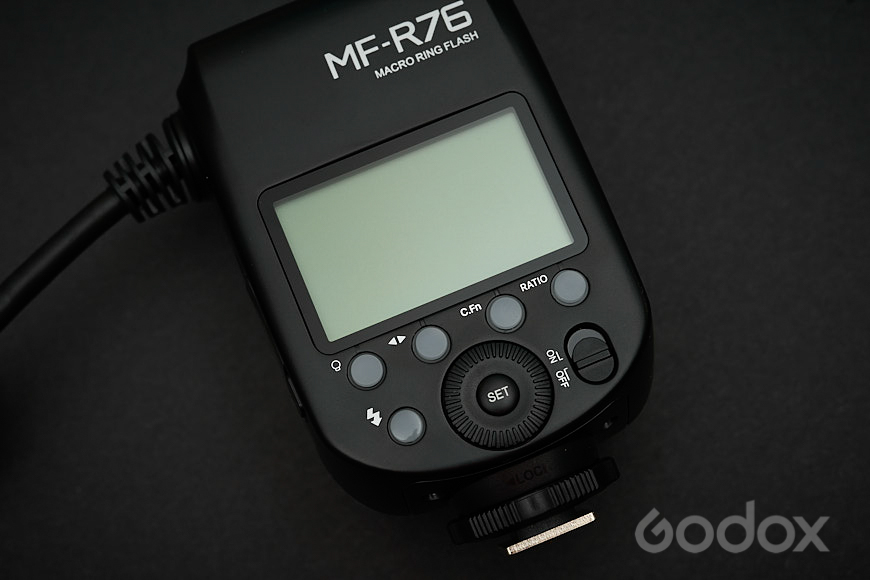
The flash control unit mounts to the speedlight mount on the camera and provides easy to use controls.
The Godox Macro Ring Flash MF-R76 consists of a flash unit and smaller accessories. The flash unit has the ring flash that attaches to the front of the lens and the trigger/battery unit mounted to the hotshoe mount on the camera.
The two units are connected via a durable, coiled cable. You also receive a selection of metal filter attachments for the most common filter thread size. These filter attachments allow you to mount the ring flash to the front of the lens.
Outside of that, there are the usual extras you’d expect with any rechargeable speedlight: a battery, charger, USB cable and a soft pouch used to protect the flash from scratches. There is no power adapter, which seems standard these days.
The charger is tiny, smaller than the battery itself, which I like. There is a little friction getting the battery in and out, but it’s not excessive.
The soft pouch provides you with a method to store the flash and accessories. It’s soft and will only really project it from scratches, not breakage.
While the soft pouch is a nice touch, a smaller sleeve or pocket for all the filter thread adapters would have been helpful. The loose filter thread adapters are likely to scratch anything in the pouch, defeating the pouch’s purpose.

A flash helps with the ability to capture motion, even with manual shutter speed limitations, as the flash can freeze action.
The quality and construction are reasonable considering the price point. I think Godox made compromises in the right places, ensuring their products still offer reliability and affordability.
The buttons on the MF-R76 feel solid and well constructed. The rotational adjustment method is not my preference but reliable enough for everyday use.
Overall, it’s a complete package with nothing major to complain about and no real deal-breakers.
The battery unit and cable are more solid than the ring flash unit. The flash ring feels lighter and cheaper, but I believe it’s a side effect of being kept lightweight to make it easier to handhold.
If I were to criticise one thing, it would be the materials and construction of the charger. It isn’t a high use item, but the plastic and construction don’t match the rest of the product, and I don’t feel the utmost confidence it will go the distance.
The flash is compatible with most camera brands that include a central pin in the hotshoe to trigger non-HSS/TTL flashes. Godox indicates it is compatible with Canon, Nikon, Sony, Panasonic, Olympus, Fuji, and Pentax DSLR cameras with a hotshoe.
However, having only tested it on Sony, I can’t comment on other individual models from other brands.
Size & Handling

The Godox MF-R76 is significant but not unwieldy when mounted on the camera. I could handhold it singlehanded for shots without discomfort if required.
The Godox Macro Ring Flash MF-R76 is on the largish side. It’s a little cumbersome, as most macro flashes are, but not unwieldy. You have to be careful when shooting close to subjects, as it’s easy to bump nearby objects.
The actual size will depend a little on the lens you use. My Laowa 100mm is on the longer end of the spectrum, so it’s one you have to be more careful of with the flash ring attached.
From a handling perspective, the MF-R76 is what you would expect from a macro flash of this type. There are some minor gripes I’ll cover on the handling front, but none of them is a showstopper.
The filter rings are great, but attaching them to the ring flash is cumbersome. They’re easy to slide in but a little harder to get out. Also, I think they could have done a better job with how the filter is locked in and released.

A macro photo of hundreds and thousands (sprinkles). Sometimes when you see a close up like this, it isn’t comforting to see what is in it out of the bottle. I have photoshopped some hairs out to save you the disgust of seeing them.
I tend to look at usability without a manual as a guide. If you don’t have to pick up the manual to use something (other than the technical setup features), that’s a positive.
In the case of the Godox MF-R76, I think the usability is as good as you can expect for the level of functionality. Outside of using the SET button to adjust the modelling light brightness, everything else is where I would expect to find it.
The SET functionality was a little odd: it’s where I would expect to see a menu or general settings area, which doesn’t exist. The icons make sense, and you don’t wonder which button to push to change functionality. The majority of the time, you’ll just be using the dial.
Light Quality

A close up of this Cape Daisy shows the high quality of the light and softness. I took this photo at 2:1 with a Sony a7RIII and Laowa 100mm 2:1 Macro lens.
It doesn’t matter so much if the build quality is good; what really matters is the light quality. Fortunately, much like with the AD200 and Godox’s various other popular lighting prodicys, the light quality on the MF-R76 is excellent, and it does not disappoint.
With a strobe background, I haven’t worked with ring flashes much before.
The light quality is much softer than I expected for a light source this size, and the ring design does an excellent job of reducing the shadows.
I’d typically work with an 80cm Octa softbox and strobe (Godox AD200) directly above an object for a lot of my product photography, but that option creates shadows from the front of the lens for the close up macro focal length 1:1 and 2:1 photos. The Godox MF-R76 mitigates this and makes it hard to see noticeable shadowing.
Whilst it is a great light source for small objects, it’s worth noting that it does suffer from considerable light fall-off that you wouldn’t get from a large light source. It’s not bad, given it’s a macro flash, but it’s essential to understand these limitations depending on what you photograph.

Close-ups with camera gear are adequate: while you do get more reflection than with something like a softbox setup, it’s still reasonable given the cost and easy setup time. This type of use case is not the intended purpose of macro flashes.
In many cases with macro, you don’t want the background to have a light on it, but the lack of master/slave means you don’t have the option of adding an additional flash if the need arises.
If you’re planning to do the style of macro that involve water droplets with refraction, you may want an additional light source for the background.
You could still use the Godox Macro Ring Flash MF-R76 to trigger a flash, so it’s not a deal-breaker, but you’re going to be doing it the old-school way of having the actual light trigger the additional speedlight rather than a wireless remote.
The ability to trigger an additional speedlight with a wireless setup like the Xpro would be an excellent addition. The Godox MF12 seems to offer this option, but I can’t comment on how it matches the light quality of the ring light.
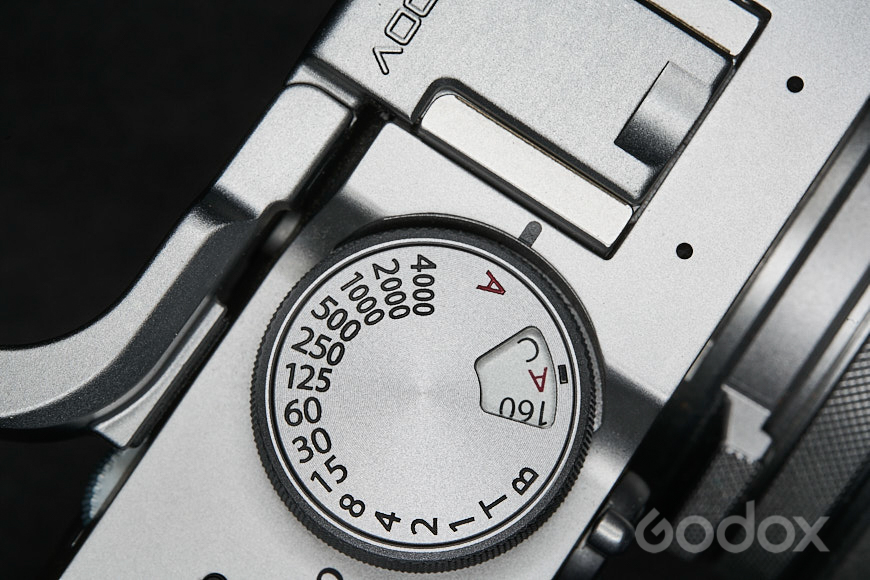
This photo shows how some of the light fall-off mentioned could be positive or negative depending on what you are shooting. For most macro scenarios, this would not be a limitation.
As you can see from the above picture of my Fujifilm X100V, no hotspots are showing on the surface. It shows how well the light is diffused with the ring flash, even with lighter colour subjects at a close distance.
The image of the Fujifilm isn’t cropped. As a result, the subject was close to the lens at the time of the photo.
Power
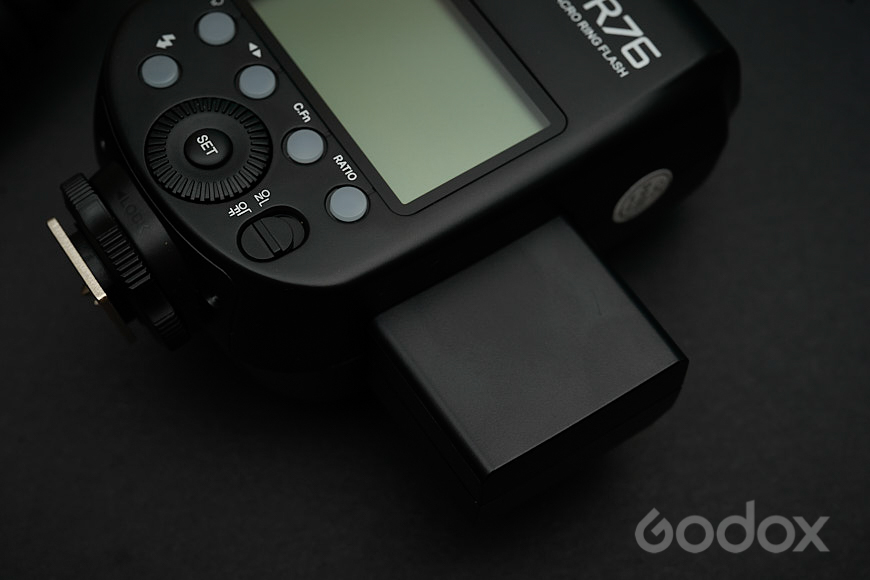
The Godox Macro Ring Flash MF-R76 comes with a rechargeable battery capable of delivering 1,000 full-power flashes.
Power to the ring flash is provided by a 7.2V 2600mAh Lithium battery that Godox claims can do 660 full-power flashes. Having spent a considerable amount of time taking photos on a single charge and not emptying the battery, I have no reason to doubt their claims.
Let’s be honest here, you’re not shooting a macro flash at full power regularly, so if over 1,000 shots is a constraint for you, I’d be interested to know what you are shooting. This should more than cover the average user’s flash requirements.
The flash offers 76Ws of power. It doesn’t sound like much, but it’s important to remember this is 76W of power positioned about 10-20cm from the subject.
Most of my time was spent at 1/16th power, occasionally 1/8th when I was outdoors. The only time I felt the need to lift it to 1/4 was to shoot at objects a little further away, well beyond the typically macro ranges.
Godox also allows you to adjust more power to the left/right or up/down (depending on how you rotate the ring on the front of the lens). This allows you to adjust them independently or switch one side off entirely if needed.
Alternatives
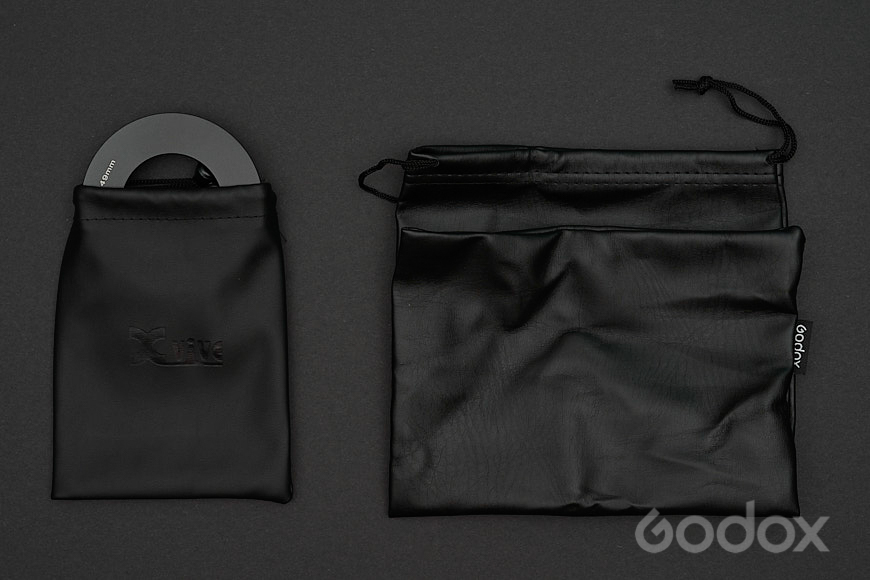
While the MF-R76 includes a nice pouch, a small bag for holding filters would be a valuable addition. Fortunately, I had one at home already from my Xvive music gear.
For alternatives to the Godox Macro Ring Flash MF-R76, you will have to look at OEM and third-party vendors, although OEM will depend on the vendor. OEM options are good, but the price point may not suit all users.
Outside of the OEMs, competitors for this product are likely to be Godox themselves and some other third party brands like Meike, Laowa and Nissan. Both Meike and Laowa offer TTL versions, whilst Godox has a slightly more expensive version with TTL for just under $100 more.
This seems to be more suited to the WYSIWYG crew who want to see what the photo looks like before they take it, but it won’t have the power for bright situations outdoors.
Flash also can freeze motion, even at non-HSS shutter speeds, so taking photos of a bee is likely to work with a flash but be blurred with an LED outdoors.
Value for Money

Stealing some sugar-coated gummies from my kids.
At around US$180, the Godox MF-R76 scores high in the value for money rankings. Unfortunately, OEM macro flashes typically come in at 3-4 times the price, which in many cases prices them out of the market.
Other third-party manufacturers are also considerably pricier than the MF-R76, making Godox the clear winner in the value for money stakes.
There are some cheap LED alternatives, but LED isn’t going to offer the same light output level, so this needs to be considered as part of the comparison. Godox does a LED ring light model at $100 cheaper called the Godox Ring72.
Whilst some will point out the lack of TTL, it’s clear that Godox has priced this at a $100 lower price point without TTL to lower the entry point for macro flash. That’s a good outcome for the consumer because you’re getting a good quality flash at a competitive price.
Godox Macro Ring Flash MF-R76 Review | Conclusion
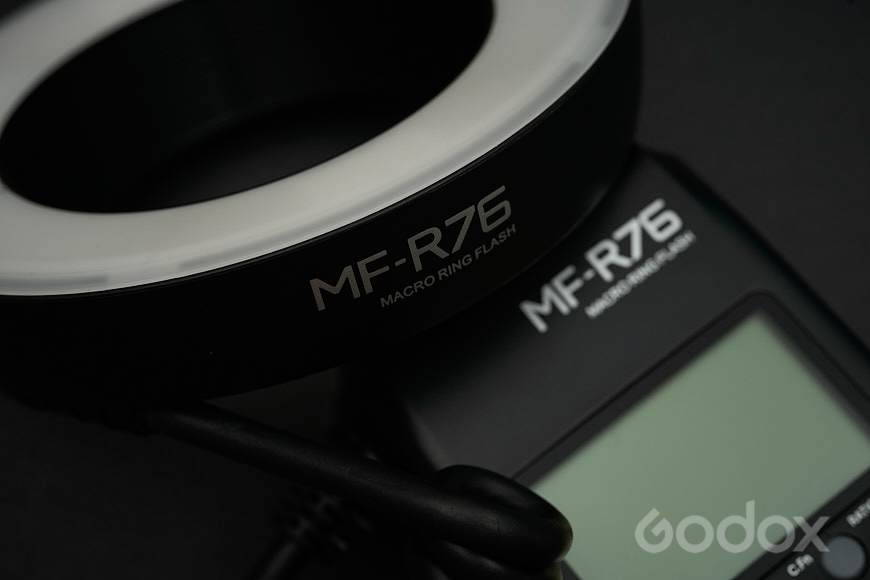
As someone who doesn’t traditionally shoot a lot of conventional macros outside of product shots, I have to say I’m suitably impressed. The Godox Macro Ring Flash MF-R76 makes it easy to shoot macro.
Except for having no TTL, it’s idiot-proof, and the low price makes it easy for macro newbies to experiment with lighting. If TTL is important, there are other options from Godox, but outside of that, I would say this is a great entry point.
The quality and diffusing of the light are surprisingly good. I wasn’t expecting much given the size of the flash, but the ring flash does a great job of limiting the shadows on the subject.
There aren’t a lot of negatives to raise about the Godox MF-R76: it’s simple, effective, and priced at a point where even non-macro photographers might consider giving it a shot.
Credits to:https://shotkit.com/godox-mf-r76-review/


